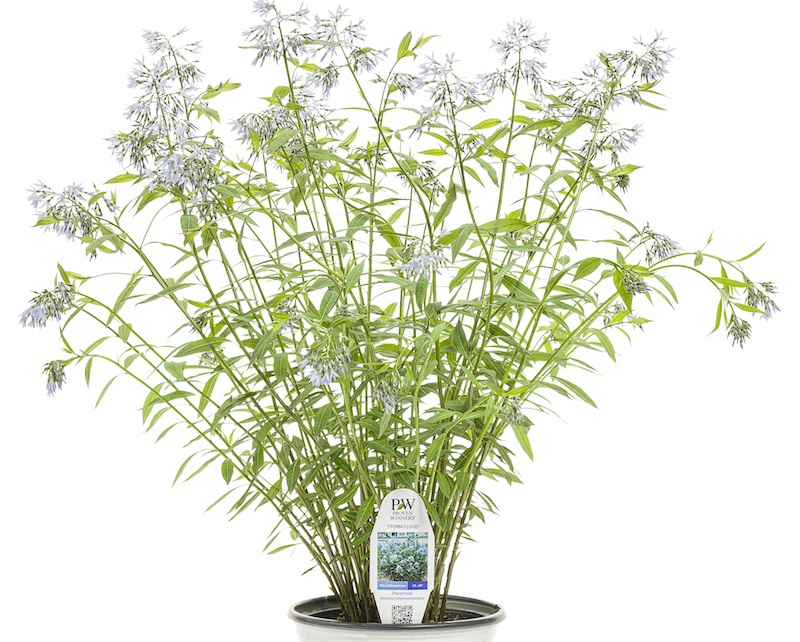Planting perennials in containers is a great way to decorate decks and patios or to create a spectacular mixed seasonal planter. Most Amsonia varieties stay compact (~3 by 3 feet), which works well for larger pots. The true blue flowers in the early summer and shocking yellow fall foliage make this plant a thriller for any plant combination.

Planting Amsonia in Pots
Plant Amsonia as soon as the soil warms in the spring. Choose a container that has excellent drainage at the bottom and will be durable in your location. Terra cotta pots perform the best in hot locations with mild, frost-free winters to prevent cracking. Composite resin, plastic and some fiberglass containers are great choices for colder climates where the pots are left outside. Situate the containers in at least 6 hours of full sun. Patios or decks that have shade very early in the day or late in the afternoon work well. A fully shaded porch or courtyard will encourage leggy, floppy growth.
Best Soil For Amsonia in Pots
Use an all-purpose potting mix that has perlite or vermiculite added to improve drainage. There is no need to choose a mix with added fertilizer. Amsonia only needs light fertilizing and could put on dense, floppy growth with too much feeding. Potting mixes with wetting agents to keep the soil moist longer are also not necessary. Allowing the container to dry between waterings ensures that the root system stays healthy with minimal chance of root rot developing.
Caring For Amsonia in Planters
Perennials can grow for years in containers as long as their watering and fertilizing needs are fully met. Watering will need to be done much more than if the plant is in the garden. The finite amount of soil in a container means that plants are more likely to suffer from underwatering. Nutrients are leached from the soil from continued watering. This means that the plants will also require supplemental feeding throughout the growing season to keep them healthy and vigorous.
Watering Amsonia in Pots
Check the soil every 1-2 days to check for dryness. Water when the top 1-2 inches of soil are dry. Water the container long enough that you see water coming from the bottom drainage holes. This ensures that all of the soil is sufficiently saturated. If you garden in a humid climate with regular summer rains, be careful to not overwater your containers.
Fertilizing Amsonia in Pots
Fertilize with a slow-release fertilizer in early spring and again in the summer after flowering has stopped. The second feeding will encourage healthy growth of the stems and foliage for the show of color in the fall. Look for fertilizers that have an NPK ratio around 5-3-3. Extremely high nitrogen fertilizers will encourage floppy stems, which can be difficult to stake in a container.
Winter Care For Amsonia in Pots
Plants growing in containers may require extra insulation or protection from harsh winter winds or heavy snow storms. Ensure that any pot left outside can withstand repeated freezing and thawing or UV exposure from the stronger sun exposure. Move any container that is not draining well under an eave or overhang. If the container is too big to move, using bricks or “pot feet” to lift the container off the ground will help water flow out. Even though Amsonia is dormant through the winter, it will not tolerate periods of standing water.
When plants grow in containers, they have less soil to buffer their roots, making them more vulnerable to cold temperatures than the same plant grown in the ground. At the lower end of their growing range (zones of 3-5), you may need to wrap the outside of pots with burlap or frostproof horticultural fabric to give the root system a little extra insulation.
Growing Amsonia Indoors
Hardy herbaceous perennials generally do not grow well indoors. They go dormant in the winter and require a period of chilling to perform well.
 |
Author Robbin Small - Published 6-06-2023 |
